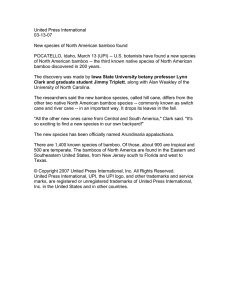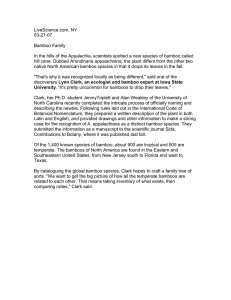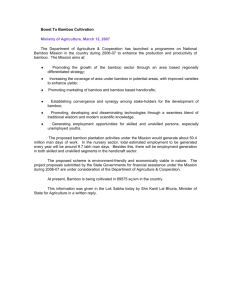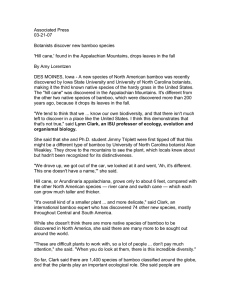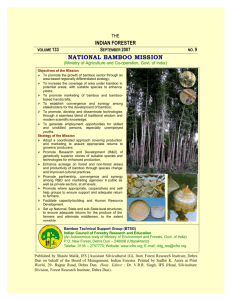NEW APPROACHES TO BOND BETWEEN BAMBOO AND CONCRETE Arash Azadeh
advertisement
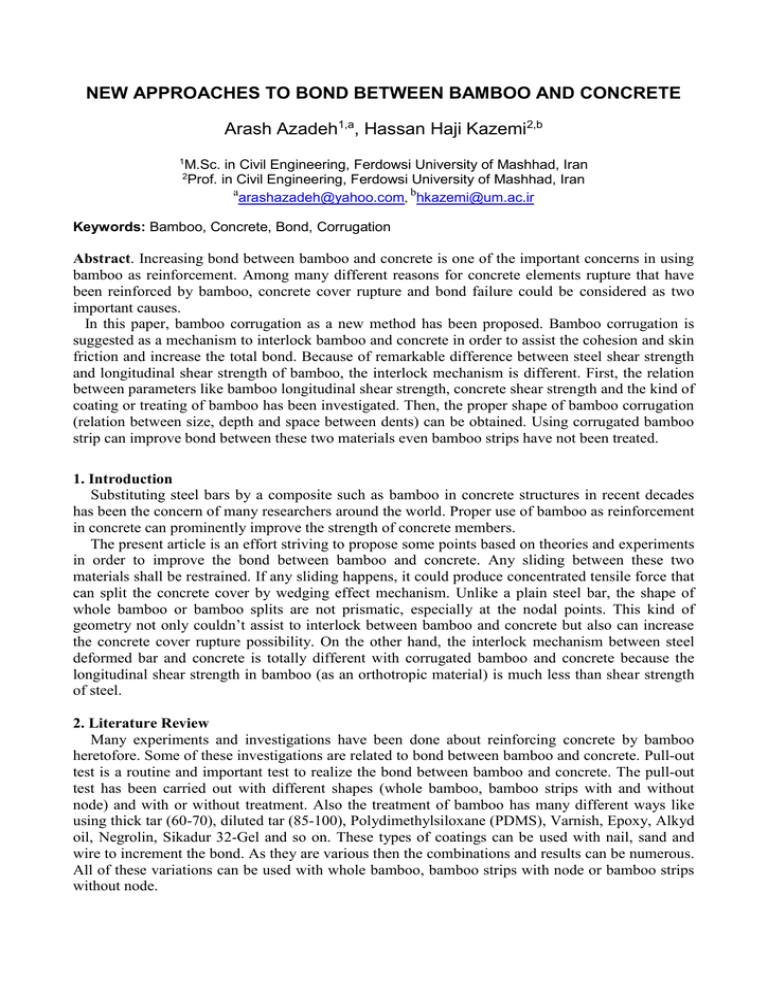
NEW APPROACHES TO BOND BETWEEN BAMBOO AND CONCRETE
Arash Azadeh1,a, Hassan Haji Kazemi2,b
1
M.Sc. in Civil Engineering, Ferdowsi University of Mashhad, Iran
Prof. in Civil Engineering, Ferdowsi University of Mashhad, Iran
a
arashazadeh@yahoo.com, bhkazemi@um.ac.ir
2
Keywords: Bamboo, Concrete, Bond, Corrugation
Abstract. Increasing bond between bamboo and concrete is one of the important concerns in using
bamboo as reinforcement. Among many different reasons for concrete elements rupture that have
been reinforced by bamboo, concrete cover rupture and bond failure could be considered as two
important causes.
In this paper, bamboo corrugation as a new method has been proposed. Bamboo corrugation is
suggested as a mechanism to interlock bamboo and concrete in order to assist the cohesion and skin
friction and increase the total bond. Because of remarkable difference between steel shear strength
and longitudinal shear strength of bamboo, the interlock mechanism is different. First, the relation
between parameters like bamboo longitudinal shear strength, concrete shear strength and the kind of
coating or treating of bamboo has been investigated. Then, the proper shape of bamboo corrugation
(relation between size, depth and space between dents) can be obtained. Using corrugated bamboo
strip can improve bond between these two materials even bamboo strips have not been treated.
1. Introduction
Substituting steel bars by a composite such as bamboo in concrete structures in recent decades
has been the concern of many researchers around the world. Proper use of bamboo as reinforcement
in concrete can prominently improve the strength of concrete members.
The present article is an effort striving to propose some points based on theories and experiments
in order to improve the bond between bamboo and concrete. Any sliding between these two
materials shall be restrained. If any sliding happens, it could produce concentrated tensile force that
can split the concrete cover by wedging effect mechanism. Unlike a plain steel bar, the shape of
whole bamboo or bamboo splits are not prismatic, especially at the nodal points. This kind of
geometry not only couldn’t assist to interlock between bamboo and concrete but also can increase
the concrete cover rupture possibility. On the other hand, the interlock mechanism between steel
deformed bar and concrete is totally different with corrugated bamboo and concrete because the
longitudinal shear strength in bamboo (as an orthotropic material) is much less than shear strength
of steel.
2. Literature Review
Many experiments and investigations have been done about reinforcing concrete by bamboo
heretofore. Some of these investigations are related to bond between bamboo and concrete. Pull-out
test is a routine and important test to realize the bond between bamboo and concrete. The pull-out
test has been carried out with different shapes (whole bamboo, bamboo strips with and without
node) and with or without treatment. Also the treatment of bamboo has many different ways like
using thick tar (60-70), diluted tar (85-100), Polydimethylsiloxane (PDMS), Varnish, Epoxy, Alkyd
oil, Negrolin, Sikadur 32-Gel and so on. These types of coatings can be used with nail, sand and
wire to increment the bond. As they are various then the combinations and results can be numerous.
All of these variations can be used with whole bamboo, bamboo strips with node or bamboo strips
without node.
For example some experiment has been carried out by Arghand [1] from Ferdowsi University of
Mashhad (1994). In this research bamboo strips have been treated in 11 different groups and each
group has 3 specimens. The final result of test summarized in Table 1.
Table 1 Bonding strength for different treatment at moment of sliding and ultimate bond strength [1]
Group
condition
𝑓𝑐′
No.
(𝑀𝑃𝑎)
1
16.0
green & with node
2
16.0
green & without
node
3
16.0
green & with node
4
5
6
7
8
9
10
11
16.0
16.0
16.0
16.0
16.0
28.6
13.1
13.1
green & with node
dry & without node
dry & with node
dry & with node
dry & with node
dry & without node
dry & with node
dry & without node
treatment method
ultimate bond
strength (𝑀𝑃𝑎)
0.71
0.24
No- treatment
No- treatment
2 layers of varnish + 1" nails at every
5 Cm
2 layers of varnish + sand
1 layer of diluted tar (85-100) +sand
2 layers of alkyd oil color +sand
1 layer of thick tar (60-70) +sand
2 layers of varnish + sand
1 layer of diluted tar (85-100) +sand
No- treatment
No- treatment
2.38
1.23
2.54
2.97
2.58
1.89
2.10
0.90
0.39
Other investigation in this regard has been done by K. Ghavami [2] from PUC, Rio de Janeiro,
Brazil (2005). In this investigation some methods for improving the bond between bamboo and
concrete have been proposed. One of the methods for improving the bond between these two
materials is using Sikadur 32-Gel. More than impermeability, this material can increase remarkably
the bond. This method can increase the bond between bamboo and concrete to 5.29 times. Table 2
as an all-inclusive table can assist to comparing different treatment methods as well as untreated
bamboo.
Table 2 Bonding strength of bamboo segment subjected to pull-out test [2]
Treatment
1. Without treatment
2. Negrolin + sand
3. Negrolin + sand + wire
4. Sikadur 32-Gel
5. Steel
Bond strength of
treated bamboo 𝜏𝑏
(MPa)
0.52
0.73
0.97
2.75
3.25
Bond strength
regarding to untreated
bamboo 𝜏𝑏 /𝜏𝑏𝑛𝑡
1.00
1.40
1.87
5.29
6.25
Sakaray et al. [3] carried out similar pull-out test. Moso type bamboo with two types of uncoated
bamboo and water proofing material coated bamboo (ALGICOAT RC-104) have been used for this
test. From Table 3 is observed that bond stresses of coated and uncoated bamboo samples are close
together.
Table 3 Pull-out test results for coated and uncoated bamboo and steel [3]
No
1
2
3
Average
Bond Stress of uncoated
Bamboo (MPa)
1.68
1.45
1.74
1.62
Bond Stress of water proof
material (MPa)
1.45
1.95
1.51
1.64
In 2011 N. Plangsriskul and N. Dorsano [4] carried out some other experiments on bond between
bamboo and concrete. Two types of bamboo - Dendrocalamus Asper and Bambusa Oldhamii – have
been considered as samples for this test. Two coatings, asphalt emulsion and polydimethylsiloxane
(PDMS), were applied to the bamboo sample ends and were tested along with the control samples,
which contained no coatings. The test results indicated that the bonding strength between the
bamboo and concrete with the asphalt emulsion coating was the greatest at 339.27 psi (2.34 MPa).
The next strongest was the control sample (no coating) at 319.07 psi (2.2 MPa), then PDMS
resulting in 154.20 psi (1.06 MPa).
Table 4 Pull-out test results for uncoated, asphalt and PDMS
coating [4]
Treatment
1. Without treatment
2. Asphalt emulsion coating
3. PDMS coating
Bond strength
(MPa)
2.2
2.34
1.06
Another important factor is using bamboo splits with or without node in pull-out test. There are
two failure modes for the bamboo with and without node during the pull out test [4] (Fig. 1). By
reviewing the results of tests which has been done by Plangsriskul and Dorsano[4], observed that
using the bamboo strips with node in pull-out test, can split the concrete (Fig. 1-b).
Fig. 1 (a) Failure mode 1: the bamboo
samples without the node were being
pulled out smoothly. (b) Failure mode
2: the samples with the node cracked
the concrete [4].
The non-prismatic shape of the bamboo splits at node can act as a wedge and produce a
concentrated tensile force in nodal area [5]. This force can split concrete cover. General shape of a
bamboo split at node is usually as below (Fig. 2):
Fig. 2 Bamboo split at node [5].
Fig. 3 (a) Strip without node (b) Strip with
node.
Stress transition between concrete and bamboo in Fig. 3-b mainly concentrated in nodal zones
that could be a weak point for using bamboo strips. These zones are the locations that cracks can be
initiated and developed.
For a bamboo strip the distance between two nodes can be divided to 3 zones (not necessarily
equal parts): 1. no-touch zone 2. skin friction zone 3. wedging action zone.
Fig. 4 Stresses on a bamboo split
between two nodes.
As it can be observed in Fig. 4, Most of tensile force (F) can be concentrated in frontal faces of
node (zone 3). Concrete cover splitting cracks can be easily initiated in this zone. For distributing
the concentrated stress 𝜎(𝑥), bamboo corrugation can be a proper solution for eliminating this
corruptive phenomenon.
3. Literature Review Results
With the same situation, the pull-out test results can be very different from together. It can be
happened because of some possible reasons:
1. Using different variety of bamboo: at the same situation, the results show that Bambusa
Oldhamii has higher pull out strengths than the Dendrocalamus Asper for all types of
coatings [4].
2. Using different type of aggregates for concrete.
3. Using sand for coating with different size and coarseness.
4. Using different amount of cement (𝑓𝑐′ ) [1].
5. Using different amount of W/C for concrete (different Slump test results).
6. The effect of bamboo Poisson’s ratio.
7. Using different shape of concrete molding (cubic or cylinder form) with different
dimensions.
8. Using different bamboo strip dimensions (thickness and width).
9. Using different pulling speed.
10. Using bamboo without coating and with different moisture content.
11. Using bamboo splits without parallel faces. The process of making bamboo splits usually
produces splits that the cut faces are not parallel together. By making them parallel the pullout results would be closer to the reality. By using narrow end in concrete the pull-out test
result can show less value than expectations but by using thick end in concrete, the bamboo
strip can act like a wedge (Fig. 5).
Fig. 5 (a) Recommended. (b) It pulls out
with less than usual force. (c) The wedging
action and concrete splitting can occur.
12. Contrary to expectations, some treatments decrease the bond strength between bamboo and
concrete. For example using polydimethylsiloxane (PDMS) coating [4] reduces the bond
to1.06 MPa comparing with 2.2 MPa for uncoated bamboo.
13. A summary result [1,2,3,4] for bond between bamboo and concrete in three different
treatment methods including: without treatment, coated and coated + sand is presented in
Fig. 6. It is observed that using sand and coating as treatment can increase the bond
between bamboo and concrete about two times:
Fig. 6 Bond strength for three
types of treatment.
4. A Proposed Method for Bond Improvement
4.1 Introduction
Like using steel deformed bar as reinforcement, corrugation of bamboo can improve the bond
between bamboo and concrete. Also bamboo corrugation can diminish the destructive effect of
shrinkage, thermal expansion and wedging effect in untreated bamboo strips.
Although, using proper coating as interface between bamboo and concrete (in addition to water
proofing) at some cases can provide adequate skin friction, but this value is much less than the
bamboo longitudinal shear strength (7.45 MPa for dry and 4.12 MPa for wet bamboo [5] versus
treated bamboo bond strength in Table 1 to Table 4). The longitudinal shear strength of bamboo is
more determinative when the interlock mechanism between bamboo and concrete is important.
Because of some similarities between reinforced concrete by steel bars and reinforced concrete
by bamboo strips, the same shapes and equations can be considered. The simplest model
representing the stress transfer between a plain bar (bamboo, steel or any other composite) and
concrete is frictional model that can be shown as Fig. 7:
Fig. 7 Frictional model [6].
In this shape the relation between parameters are simple (𝐷𝑏 : bar diameter - 𝜇: friction
coefficient - 𝜎𝑙𝑎𝑡 : lateral tension –𝐶: adhesion):
𝑑𝐹 = 𝜏. 𝜋. 𝐷𝑏 . 𝑑𝑥
𝜏 = (𝜇. 𝜎𝑙𝑎𝑡 + 𝐶) .
(1)
In this type, the skin friction is directly depend on lateral tension (compression) and friction
coefficient.
The theory of interlocking between deformed bar and concrete is different from using a prismatic
and plain bar (Fig. 8).
Fig. 8 Bond force transfer mechanism in
a deformed bar [7].
In this mechanism, the failure surface would be a cone that is started from dents and the base of
cone is toward the tensile force [8]. Due to remarkable difference between steel shear strength and
longitudinal shear strength of bamboo (7.45 𝑀𝑃𝑎 for dry and 4.12 𝑀𝑃𝑎 for wet bamboo [5]), all of
assumptions and calculations are different. In a steel deformed bar, the root connection of the dent
(𝑏) regarding to distance between dents (𝑐) is small (Fig. 9-1). It can be justified because of
remarkable difference between steel and concrete shear strength.
Fig. 9 (1) Typical shape of a steel deformed
bar (2) Bamboo corrugated strip.
As the bamboo longitudinal shear strength and concrete shear strength are close together then the
length of dent (𝑏) would be closer to distance between dents (𝑐):
Because of proper bamboo workability, it can be easily filed and corrugated in field. By using
this method for improving the bond, the necessity of using other chemical coating for increasing the
bond will be lessened.
4.2 Theory
Three main factors can justify the corrugation of bamboo strips. There are: 1. high capacity of
bamboo compression strength, 2. adequate longitudinal shear strength of bamboo beside skin
friction or adhesion and 3. proper shear resistance of concrete.
Some typical shapes of bamboo corrugation could be presented as below (Fig. 10):
Fig. 10 Some typical shapes of
bamboo corrugation.
The first one in Fig. 10 can be chosen as the simplest shape for modeling. It is important to find
the relations between b, c and h. Two independent equations can relate these three geometrical
parameters (b, c and h) together. Then by defining one of them, the two others can be achievable.
For this purpose the equilibrium equations shall be extracted from Fig. 11:
Fig. 11 Skin friction, shears and
compression on a corrugated
bamboo split.
𝜏𝑐𝑏 : Skin friction between bamboo and concrete
𝜏𝑏 : Bamboo longitudinal shear tension
𝜏𝑐 : Concrete shear tension
𝜎𝑐𝑏 : Compression between bamboo and concrete
Relation between b and c: in order to finding relation between these parameters at first a
diagram only for one period of denting (containing a bamboo dent and one distance between two
dents) should be extracted from Fig. 11:
Fig. 12 Tensions in one period of
corrugation.
Skin friction plus shear in each material in row 1 and row 2 in Fig. 12 should be the same (these
are valid only when 𝜏𝑐𝑏 < 𝜏𝑏 and 𝜏𝑐𝑏 < 𝜏𝑐 ):
𝜏𝑏 × 𝑏 + 𝜏𝑐𝑏 × 𝑐 = 𝜏𝑐 × 𝑐 + 𝜏𝑐𝑏 × 𝑏 →
𝑏 𝜏𝑐 − 𝜏𝑐𝑏
=
.
𝑐 𝜏𝑏 − 𝜏𝑐𝑏
(2)
Relation between h and b (or c): For the bamboo element between row 1 and 2 in Fig. 12, the
equilibrium equation would be as below (the same diagram and equation can be drafted and written
for concrete element):
Fig. 13 Bamboo element (dent) between
row 1 and 2.
ℎ (𝜏𝑏 − 𝜏𝑐𝑏 )
ℎ (𝜏𝑐 − 𝜏𝑐𝑏 )
=
𝑜𝑟 =
.
𝑏
𝜎𝑐𝑏
𝑐
𝜎𝑐𝑏
(3)
These two equations (Eq. (2 & (3) can define relation between b, c and h. by assuming one of
these parameters, two others can be calculated easily. For 𝜎𝑐𝑏 , the minimum value among ultimate
bamboo compression stress (𝜎𝑏 ) and ultimate concrete compression stress (𝜎𝑐 ) should be
considered.
𝜎𝑐𝑏 = min(𝜎𝑐 , 𝜎𝑏 ) .
(4)
Then the proportional relation between 𝑏, 𝑐 and ℎ can be written as below:
ℎ: 𝑏: 𝑐 = ℎ:
𝜎𝑐𝑏
𝜎𝑐𝑏
ℎ:
ℎ .
(𝜏𝑏 − 𝜏𝑐𝑏 ) (𝜏𝑐 − 𝜏𝑐𝑏 )
(5)
The percentage of bond increment due to corrugation: In this section the amount of bond
increment for untreated and different types of treatment due to corrugation are investigated. If the
section area of bamboo strip is considered as a rectangular, then for each side and for one period of
corrugation, 𝜏𝑎𝑣𝑒 can be calculated as below:
𝜏𝑎𝑣𝑒 =
𝜏𝑏 𝜏𝑐 − 𝜏𝑐𝑏 2
.
𝜏𝑏 + 𝜏𝑐 − 2𝜏𝑐𝑏
(6)
As the corrugation is done for two opposite sides then totally average bonding stress for two
sides from four sides of corrugation (𝜏𝑡𝑜𝑡(2) ) would be:
𝜏𝑡𝑜𝑡(2) =
𝜏𝑎𝑣𝑒 + 𝜏𝑐𝑏
.
2
(7)
Generally for 𝑛 sides corrugation (up to maximum 4 sides) the totally average bonding stress
(𝜏𝑡𝑜𝑡(𝑛) ) will be calculated as below:
𝜏𝑡𝑜𝑡(𝑛) =
𝑛𝜏𝑎𝑣𝑒 + (4 − 𝑛)𝜏𝑐𝑏
.
4
(8)
Then the percentage of bond stress increment (𝛼) for 𝑛 sides is:
𝛼% =
𝜏𝑡𝑜𝑡(𝑛) − 𝜏𝑐𝑏
× 100 .
𝜏𝑐𝑏
(9)
4.3 Practical Example
As a practical example, the numerical values of some parameters like 𝜎𝑐𝑏 , 𝜎𝑐 , 𝜎𝑏 , 𝜏𝑏 , 𝜏𝑐 and
𝜏𝑐𝑏 that have been defined already, will be used here then the relation between these three
parameters can be obtained.
Concrete compressive stress (𝜎𝑐 ) can be considered as 𝑓𝑐′ and for this example at mid range it
has been taken as 21 𝑀𝑃𝑎 but bamboo compressive stress (𝜎𝑏 ) can be too variable and depends on
different varieties of bamboo and different moisture content (wet or dry). The compression stress
that has been measured by Godbole et al. [9] from department of aeronautical engineering, Indian
institute of technology (1986), for dry bamboo splits 63.2 𝑀𝑃𝑎 and for soaked in distilled water for
144 hr, 34.3 MPa has been reported.
Then:
𝜎𝑐𝑏 = min(𝜎𝑐 , 𝜎𝑏 ) = 𝑓𝑐′ = 21 𝑀𝑃𝑎 .
(10)
(Note: as 𝜎𝑐 is always less than 𝜎𝑏 in both dry and water saturated condition, then in this
conditional equation 𝜎𝑐𝑏 = 𝑓𝑐′ has been selected.)
For wet and dry bamboo longitudinal shear strength [5]:
4.12 𝑀𝑃𝑎 for wet bamboo
𝜏𝑏 = {
7.45 𝑀𝑃𝑎 for dry bamboo .
(11)
The behavior of concrete between dents as a shear element is complicated. Finding the exact
value for concrete shear strength in this special case needs more investigation. Concrete tensile
stress is about 10 to 15 percent of the compressive strength [10] or can be √𝑓𝑐′ /1.8 [11]. By a
Mohr’s Circle analysis based on tensile and compressive strength of concrete, the shear strength of
concrete can be indicated. But it should be reminded that this value is only a rough estimation of
concrete shear strength:
Fig. 14 Mohr’s Circle based on tensile and
compressive strength of concrete.
By considering 𝑓𝑐′ = 21 𝑀𝑃𝑎 , shear strength based on Mohr’s Circle is:
𝜏𝑐 = 0.74(𝑓𝑐′ )3/4 = 7.3 𝑀𝑃𝑎 .
(12)
For 𝜏𝑐𝑏 or adhesion shear tension between bamboo and concrete, the value can be extracted
from Table 1 to Table 4.
It should be noted that the restrictive factor in this regard is the depth of corrugation (h). The
worse case is related to using water saturated bamboo split (untreated) in concrete. Maximum
tangential strain is equal to 0.048 [5]. Then by using a 4 𝐶𝑚 width bamboo split, maximum
shrinkage in tangential direction will be equal to:
𝛿𝑡𝑎𝑛𝑔𝑒𝑛𝑡𝑖𝑎𝑙 = 40𝑚𝑚 × 0.048 = 1.92𝑚𝑚 .
(13)
The notch should cover this value then it should be more than 1.92 𝑚𝑚. On the other hand, by
increasing the depth of notch, the remaining depth will be decreased and the result would be the
decrement of effective tensile area. By considering the above mentioned factor and depth of notch
for each side about 5% of width of bamboo and assuming 4 𝑐𝑚 for width of bamboo strip, 2 mm at
each side could be proposed as the optimum depth of notch or ℎ.
Eventually for untreated and water saturated bamboo, the proportional relation between 𝑏, 𝑐 and
ℎ by using equation (5) and ℎ = 2 𝑚𝑚 will be calculated as below (for example 𝜏𝑐𝑏 = 0.52 𝑀𝑃𝑎
has been considered for untreated bamboo):
ℎ: 𝑏: 𝑐 = 2:
21
21
× 2:
× 2 = 2 ∶ 12 ∶ 6 .
4.12 − 0.52
7.3 − 0.52
(14)
In this case, 𝜏𝑎𝑣𝑒 and 𝛼 can be calculated by using Eq. (6) to (9) only for one face:
𝜏𝑎𝑣𝑒 = 2.87 → 𝛼 = 450% .
(15)
A table for other treating method with or without considering skin fiction based on Table 2 has
been prepared:
Table 5 The increment percentage of skin friction and related corrugating dimensions
Case
1. wet bamboo without
treatment
2. wet bamboo without
treatment (skin friction
ignored)
3. bamboo treated with
negrolin + sand
4. bamboo treated with
negrolin + sand (skin
friction ignored)
5. bamboo treated with
negrolin + sand+wire
6. bamboo treated with
negrolin + sand+wire
(skin friction ignored)
7. bamboo treated with
Sikadur 32-Gel
𝛼
ℎ
𝑏
𝑐
(mm)
(mm)
(mm)
%
450
2
12
6
𝜏𝑐
𝜎𝑐𝑏
𝜏𝑏
𝜏𝑐𝑏
𝜏𝑎𝑣𝑒
(MPa)
(MPa)
(MPa)
(MPa)
(MPa)
7.3
21
4.12
0.52
2.87
7.3
21
4.12
0
2.63
-
2
10
6
7.3
21
7.85
0.73
4.15
470
2
6
6
7.3
21
7.85
0
3.78
-
2
5
6
7.3
21
7.85
0.97
4.27
340
2
6
7
7.3
21
7.85
0
3.78
-
2
5
6
7.3
21
7.85
2.75
5.15
87
2
8
9
5. Conclusion
Some of the results that can be inferred from this investigation can be summarized and listed as
below:
1. The first and the most important advantage of corrugation is the increment of bond between
bamboo and concrete.
2. Uniform distribution of transferring load between bamboo and concrete by bamboo
corrugation.
3. Using corrugated bamboo strips can be practicable for temporary structures with using it in
the mortar or concrete without any special coating and extra costs.
4. Corrugation can reduce the wedging effect because of changing the stress transition
mechanism between bamboo and concrete.
References
[1] M.A. Arghand, Concrete reinforcement by Bamboo, M.Sc. thesis, Ferdowsi University of
Mashhad, 1994.
[2] K. Ghavami, Bamboo as reinforcement in structural concrete elements. Cement & Concrete
Composites 27, 637–649, 2005.
[3] H. Sakaray, N.V. Vamsi Krishna Togati, I.V. Ramana Reddy, Investigation on Properties of
Bamboo as Reinforcing Material in Concrete. International Journal of Engineering
Research and Applications (IJERA), Vol. 2, Issue 1, Jan-Feb 2012, pp.077-083.
[4] N. Plangsriskul, N. Dorsano, Materials Characterization of Bamboo and Analysis of
Bonding Strength and Internal Strength as a Structural Member in Reinforced Concrete,
California Polytechnical State University San Luis Obispo, Materials Engineering, Senior
Project, 2010-2011.
]5[ A. Azadeh, Experimental and Theoretical Investigation of Bamboo & Concrete Interaction,
M.Sc. thesis, Ferdowsi University of Mashhad, 1999.
]6[ S.P. Tastani, S.J. Pantazopoulou, Experimental Evaluation of The Direct Tension -Pullout
Bond Test. Bond in concrete from research to standards, Budapest, Hungary, 2002.
]7[ ACI Committee 408R (2003), Bond and Development of Straight Reinforcing Bars in
Tension. Journal of the American Concrete Institute.
]8[ K. Maekawa, A. Pimanmas, H. Okamura, Nonlinear Mechanics of Reinforced Concrete.
Spon Press, 2003.
[9] V.S. Godbole, S.C. Lakkad, Effect of Water Absorption on the Mechanical Properties of
Bamboo. Journal of Materials Science Letters 5, 303- 304,1986.
]10[ ACI Committee 318 (2005), Building Code Requirements for Structural Concrete and
Commentary. ACI 318M-05, R10.2.5.
]11[ ACI Committee 318 (2005), Building Code Requirements for Structural Concrete and
Commentary. ACI 318M-05, R11.2.1.1.

